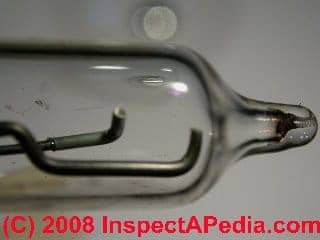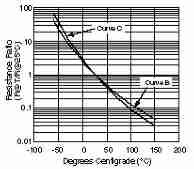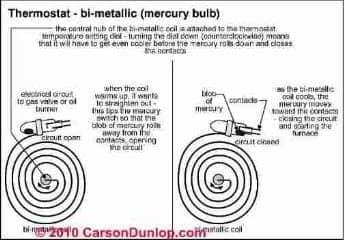 How Room Thermostats Responds to Changes in Room Temperature
How Room Thermostats Responds to Changes in Room Temperature
- POST a QUESTION or COMMENT about heating and air conditioning thermostat operating properties
How room heating or cooling thermostats work in response to temperature changes.
This article explains in detail the diffrent types of temperature sensors used in heating and cooling room thermopstats and how heating or air conditioning thermostats actually work.
We explain how a bimetallic spring operates to move a mercury bulb switch, how mercury bulb switches operate, how a snap action thermostat or a thermostor operated thermostat works. We define switch make and switch break modes.
This document will help repair technicians and building occupants to understand wall thermostats, their use, setting, and adjustment. Page top sketch of how a mercury bulb type bimetallic spring thermostat operates was provided courtesy of Carson Dunlop Associates, a Toronto home inspection, education & report writing tool company [ carsondunlop.com ].
InspectAPedia tolerates no conflicts of interest. We have no relationship with advertisers, products, or services discussed at this website.
How the Honeywell Room Thermostat Senses & Responds to Temperature Changes
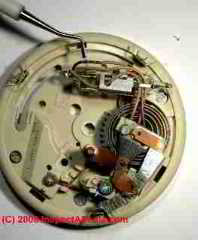 Article Contents
Article Contents
- BIMETALLIC SPRING TEMPERTURE SENSORS
- BIMETALLIC SPRING MOVES SWITCH
- DEFINE SWITCH Break & SWITCH Make MODES
- MERCURY BULB THERMOSTAT OPERATION
- SNAP ACTION BIMETALLIC SPRING OPERATION
- THERMISTOR OPERATION & TEMPERATURE CHAET
- TYPES of ROOM TEMPERATURE SENSORS
- TROUBLESHOOT ACCURACY & RESPONSE of THERMOSTATS
Mercury Bulb and other Bimetallic Spring Room Thermostats & How They Work
Bimetallic Springs & How They Operate as Temperature Controls
This and other older room thermostats sense room temperature by the combination of a bimetallic spring and a switch that the spring moves as its position changes in response to temperature changes in the room.
The round, coiled bi-metallic spring in the thermostat shown in this photo has been used various shapes in lots of other control devices that respond to temperature changes, such as the furnace or boiler stack relay switch.
Two metal strips, each of different properties, are sandwiched together and then coiled (center-right in our photo) to form a spring.
Because the thermal coefficient of expansion of the two metals are different, and because the two metal strips are adhered together, as temperature changes the spring will bend or flex.
As the bimetallic thermostat temperature sensing spring flexes it expands or shrinks as temperature rises or falls. This causes a movement of the spring.
How the Bimetallic Spring Moves an Electrical Switch or Mercury Bulb
A sensor or switch attached to the end of the spring is mechanically moved and in turn is used to turn a device "on" or "off".
In our photo above our little dental tool points to a mercury switch which makes or breaks electrical contact to actually turn on or off the control to which our thermostat has been attached. You can see some wires leaving the glass mercury bulb and heading off to other contacts inside the thermostat.
Just below, in our photo the bimetallic coil spring has tilted the mercury-bulb so that it tips to roll its blob of mercury away from two metal contact wires that are sealed, along with the mercury, inside of the glass bulb. The switch is "open" or "off" - there is no call for heat.
Below, the bimetallic spring has contracted (it got cold), causing the bulb to tip so that the mercury rolls down the inside of the tube and contacts the two wires inside the bulb, completing an electrical contact to switch the AIR CONDITIONER (OFF) or the HEATING SYSTEM (ON) depending on the mode (cooling or heating) in which the thermostat is being used.
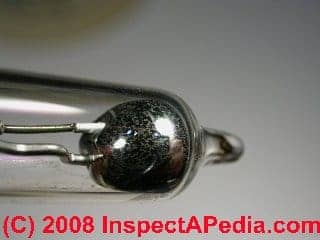
This swapping of the role of the switch in turning something OFF in response to a temperature drop (cooling mode) or ON in response to a temperature drop (heating mode) is why a dual-purpose thermostat will also have an extra switch to decide whether we're controlling heating or cooling.
Definition of Switch Break & Switch Make Modes
To avoid confusion about what a mercury bulb switch or any other kind of switch is doing, electricians call the left photo condition "switch break" mode and the right photo condition "switch make" mode because the switch is "breaking" or "opening" a circuit when contacts are disconnected, and a switch is "making" or "closing" a circuit when its electrical contacts are connected.
How Mercury Bulb Thermostat Switches Work & Why a Thermostat is Just an On-Off Switch, not an Accelerator
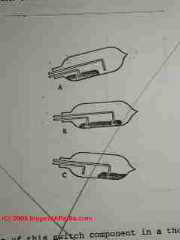 Anyone who understands how a mercury bulb thermostat works to simply "make" or "break" an electrical circuit will see clearly and forever that a room thermostat is not an accelerator, it is an on-off switch that responds to temperature changes.
Anyone who understands how a mercury bulb thermostat works to simply "make" or "break" an electrical circuit will see clearly and forever that a room thermostat is not an accelerator, it is an on-off switch that responds to temperature changes.
So if you're cold, and the room temperature and room thermostat are both reading 55 °F., turning the thermostat to any temperature above that will cause the heating system to turn on.
Turning the thermostat up to 95 °F will not warm the room any faster than turning the thermostat up to 65 deg F.
Our little sketch explains how the traditional mercury switch worked in the old Honeywell (R) round wall thermostats.
As room temperature changes, a bimetallic coil-spring moves to tip the glass bulb in either direction, up or down. As temperature drops the bulb tips to the left (the spring contracts) and the mercury, at point (B), connects the two contacts to turn on the heating system.
Modern thermostats no longer use mercury switches (mercury is a toxic product) but they function similarly in response to room temperature.
Mercury is a toxic substance which is no longer used in thermostat switches, but there are millions of these devices still in place in homes.
You should ask your local or state department of environmental protection/conservation if your area has special requirements when one of these old mercury bulb thermostats is to be thrown away.
How is a "Snap Action" bimetallic-spring Room Thermostat Different from a Mercury Bulb Thermostat?
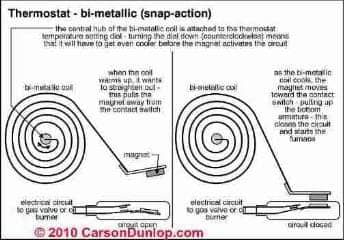
As Carson Dunlop Associates ' sketch illustrates, a bimetallic-spring snap-action room thermostat works almost exactly the same as the older mercury bulb thermostat illustrated above in this article.
But to eliminate the requirement to use mercury (a hazardous substance) the bulb of mercury found inside the glass capsule and used to complete the circuit or "close the switch" to turn on heating or air conditioning has been replaced by a mechanical switch.
When the bimetallic spring end approaches the fixed glass bulb, a magnet on the end of the spring pulls closed the tip of the electrical switch to operate the cooling or heating appliance.
[Click the image to see an enlarged version and to read more operating details for this type of thermostat control.]
Types of Room Thermostat Temperature Sensors & How they Work
How Bimetallic Element thermostats work
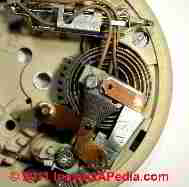
Bimetallic Element thermostats use a bimetallic spring consisting of strips of two different metals fused together, typically into a coil shape. Our photo (left) shows a coiled spring inside a mercury tube based room thermostat made by Honeywell®.
As the fused metal strip/coil is exposed to different room air temperatures, because the two metals expand or contract at different rates but are fused together, the spring "coils" or "un-coils", causing the spring end to move in response to temperature.
This movement can be used to open or close contacts to turn heating or cooling on or off in a building.
The movement of the bimetallic spring may move a mercury bulb that acts as a switch (described below) or it may operate a snap-type mechanical switch to turn heating or cooling on or off.
See TEMPERATURE RESPONSE of ROOM THERMOSTATS for a detailed description of how bimetallic springs used in room thermostats work.
How Bellows Element thermostats Work
Bellows Element thermostats are filled with a volatile liquid that vaporizes at temperatures typically found indoors.
As the liquid vaporizes pressure inside the bellows expands, translating temperature change into the movement of a contact to turn heating or cooling on or off in response to building temperature.
Photographs of a bellows-operated line-voltage room thermostat produced by Honeywell, Inc., are found at Honeywell or in Burkhardt.
Mercury-tube Element thermostats

Mercury-tube element thermostats use a glass tube containing mercury and a pair of metal contacts at one end of the tube to turn heating or cooling on or off in a building.
The mercury tube is connected to a bimetallic spring that tips the mercury tube in response to changing room air temperature.
When the tube tips in a direction that causes the mercury to move to the end of the tube containing two metal contact wires, the mercury acts as a conductor to close an electrical connection to turn heating or cooling on.
When the tube tips in the opposite direction the mercury moves off of the contacts and the switch is opened or heating /cooling are turned off.
How Thermistor-Controlled Room Thermostats Work: photos & temperature chart
Thermistor-type thermostats use a tiny solid-state electronic component, a type of resistor whose electrical resistance changes in response to temperature.
You'll notice in our photo of a thermistor found inside a Honeywell CT2700 Electronic Round Programmable Thermostat that the device is deliberately connected using long wire leads so that it can ride in room air away from influence by heat generated on the thermostat's own internal circuit board.
Our photo (below left) shows a thermistor used in a room thermostat. We had to take the thermostat apart and use our lab microscope to take this photo - this is a detail you won't normally see when installing a room thermostat. But it's there.
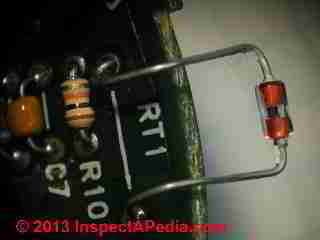
Thermostats control within a narrow range, say +/1 1 °F by using a thermistor combined with a high gain amplifier to obtain sensitivity down to 0.005oC!. What about reliability? Thermistors, properly selected for the environment, can be quite durable.
Nevertheless, some thermostats or HVAC equipment include a "safe-default" operating mode to keep the system working in the event that the thermistor should fail.
Thermistor details such as how they work, definitions of types, features, and more photographs of thermistors are
at THERMISTORS.
Thermostat Heaters, heat accelerators, heat anticipators
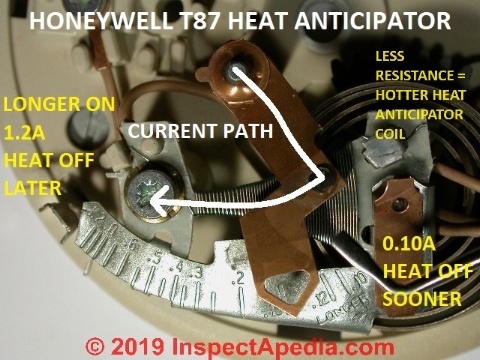
Some thermostats models also use a source of artificial heat (a very tiny resistor or resistance heating element inside the thermostat) to force the heating system to turn off earlier than it would have if the thermostat only responded to an increase in room temperature.
In other words, the heating system itself will be turned off before the room temperature has reached the thermostat set point.
This feature is added to prevent the heating system from "overshooting" or making the room too warm - a condition that might occur due to additional heat that will be radiated into the room from radiators or heating baseboards that will continue to be warm even after the steam boiler or the hydronic boiler circulator has shut off.
To accommodate variations in heating source and distribution design, heat accelerators or heat anticipators are usually adjustable.
Reader Comments, Questions & Answers About The Article Above
Below you will find questions and answers previously posted on this page at its page bottom reader comment box.
Reader Q&A - also see RECOMMENDED ARTICLES & FAQs
Thermostat Accuracy: Settings vs Room Temperature
 Reader Question: Honeywell RTH 2300 thermostat in cool mode accuracy
Reader Question: Honeywell RTH 2300 thermostat in cool mode accuracy
13 Aug 2015 Bryan said:
Office environment with a HONEYWELL RTH2300 thermostat . . . in Cool mode Fan On and set to 75F Hold. Cooling does not click on until 77F reached on display temp . . . and does not click off until 73F reached on display temp.
I would think cooling should click on when above 75F, ie at 76, and click off when below 75F, ie at 74F. Is this operating within standard tolerance? Is the thermostat defective? Is there any means to rectify to hold at 75F?
Right now there is a 4 degree variance which at 77F is slightly too warm and at 73F is slightly too cool - would be better clicking on at 76F and off at 74F.
Thought about changing the batteries but don’t think that should have any effect as cooling is clicking on and off OK and display reading OK just at higher and lower temps than the setting. Any comments or suggestions to rectify would be greatly appreciated.
Moderator (DF) Reply: The RTH 2300 thermostat is designed to control temperatures to +/- 1° F.
Good question, Bryan. I like the Honeywell RTH 2300 thermostat series an have installed a number of them without having the trouble you describe.
I'd expect the thermostat to respond just as you do. And I'm doubtful that batteries are the problem.
Looking at Honeywells' FAQs for the RTH2300 the company says that the thermostat accuracy is +/- 1° Farenheit
Your thermostat is designed to control temperature to +/- 1° F.
How often your heat turns on and off depends on may factors including the type of heating system you have, as well as how much your system needs to run to maintain your temperature setting (in other words, how cool or cold it is outside). A typical forced air system will cycle about five times in an hour (5CPH), this is normal. A typical hot water system would cycle less then that.
This FAQ expands on the question of why the temperature displayed by the thermostat may not match other temperature measurements made in the home
Why does the thermostat temperature not match my temperature thermometer in my home?
Answer: Honeywell digital thermostats are designed to display the room temperature in a way similar to how people sense temperature. This means the thermostat takes into account not just the ambient air temperature but also the radiant temperature of objects in the room (i.e., wall and furniture). Room thermometers often only read ambient air temperature so they will not match the thermostat reading.
Also, Honeywell thermostats do round in the display to the nearest whole number (half number in Celsius) and to the temperature setting. For example, if you have the thermostat set to 72 degrees the system will turn on and off but the inside reading on the thermostat never changes from 72. The actual temperature did fall to 71 or up to 73 and that is what turned on the heating or cooling but the thermostat display will stay at 70 to avoid jumping up and down constantly. - retrieved 13 Aug 2015, original source: http://yourhome.honeywell.com/home/Products/Thermostats/5-2-Day-Programmable/RTH2300B.htm
See TEMPERATURE RESPONSE of ROOM THERMOSTATS for details.
A programmed setting can confuse us about how the thermostat should be responding.
But if you've got the thermostat in HOLD mode then it ought to respond to temperature changes around the hold temperature setting. Double check that you see the word "HOLD" in the display.
Honeywell RTH 2300 Thermostat Diagnostics
The Honeywell RTH 2300 thermostat has some self-diagnosing circuitry and other features showing up in its display
- The thermostat will display low battery ("Lo Batt") for 60 days before the battery is dead
- HI: the ambient temp is above 120F
- LO: the ambient temp is below 32F - these are the operating limits of the device
- E1 or E2 = bad sensor, replace the thermostat
- The Honewywell RTH 2300 has a built-in compressor protection circuit that the company describes as follows:
This feature helps prevent damage to the compressor in your air conditioning or heat pump system. Damage can occur if the compressor is restarted too soon after shutdown. This feature forces the compressor to wait 5 minutes before restarting.
During the wait time, the display will flash the message Cool On (or Heat On if you have a heat pump). When the safe wait time has elapsed, the message stops flashing and the compressor turns on. - retrieved 13 Aug 2015, original source https://customer.honeywell.com/resources/techlit/TechLitDocuments/69-0000s/69-2326ES.pdfI'd give the company a call to ask about the response you're experiencing: but FIRST inspect the TT closely to be sure that no clod of dust or crud is blocking the little thermistor that senses temperature. Contact the company directly at:
- DIYthermostats.honeywell.com.
- Honeywell Customer Care toll-free at 1-800-468-1502
Reader Follow-up: - Thermostat is in "HOLD" mode
Thanks for the prompt response and clarification.
Unit is definitely in "Hold" mode.
Not displaying "Lo Batt".
Will inspect for blockage on the temperature sensor - assuming I can figure out what that is. - Bryan 13 Aug 2015
Moderator (DF) Reply: check the thermostat's thermistor for dust or debris clogging
Look closely at all sides of the thermostat. If I recall, on the right side you'll see, through a small gap in the plastic, a small thermistor sticking out in the air. That part could be blocked or bad.
Our photo at left shows the thermistor of a different model thermostat (not yours), observed from the back side of the device.
One can often spot the little orange thermistor by peering into an air gap at the side of the thermostat.
See THERMISTORS for more examples of these devices, what they look like and how to spot them.
Bottom line, the thermostat ought to respond to 1-3 degrees of temperature change.
I looked for but didn't see an explicit spec on that range.
If the response were too sensitive the unit would short cycle which is death for AC and some heating systems. So at 2 degrees Honeywell may say you're in-spec.
Reader follow-up:
I took the stat apart and did not see anything unusual - will have another look.
We have another H/W Stat, aslightly lesser grade model in our gym. It is sent to Cool Hold 72F and is always at 72F when I am in there.
Frustrating, sitting here, the thermostat is set to Cool /Hold / 74F and is reading 76F and the A/C is not on.
You may be right that we are within spec and I understand that excessive starting and stopping would not be good for the A/C unit, but this temperature variance is beyond a comfort level as well.
I will probably phone H/W to see what their response is.
Thanks again for your comments and assistance! - Bryan 13 AUg 2015
Moderator (DF) Reply: Check to see if the thermostat is calling for cooling or not
It sounds to me as if the thermostat is out of spec but before calling Honeywell I would check whether or not the thermostat is actually calling for cooling.
The device is ultimately a simple on-off switch. If it is calling for cooling then the cooling wires from the thermostat ought to be "making" or joined electrically - something one can test with a simple VOM at the air handler or compressor/condenser unit of your system: find where your thermostat wires go and check there.
If the TT is not calling for cooling and there is a 2 or more degree spread between what it says is room temperature and what it says you've set the temperature to (2 degrees or more below room temperature) then we'd expect the device to call for cooling.
Reader follow-up: Inquiry sent to Honeywell about thermostat's response to room temperature
13 Aug 2016 Bryan said:
1. It is longer than 5 mins between cooling starting and shutting off or shutting off and starting so not having any issues with the flashing message.
2. The response to the question about the home T/S is very curious tho . . . says the temperature never changes on the T/S despite room temp changing a degree or two . . . that is definitely not the case with our T/S . . . as stated previously if set at 75F the T/S temp reading will raise to 77F before cooling engages . . . and will drop to 73F before cooling cancels . . . it does not maintain a constant reading of 75F.
3. If the T/S is designed to control temp to +/- 1F, then I suppose that is what it is doing. If the thermostat is set at 75F and temperature raises to 76F that is +1F and within the +1 tolerance. When temperature raises one more degree to 77F then that is 1F above the 76F tolerance level and cooling begins.
Conversely when cooling and the temp falls to 74F that is within 1F of tolerance so cooling continues until the temp falls to 73F which is now beyond the 1F tolerance of 74F and cooling cancels. I suppose that within this parameter the unit is function properly although slightly beyond the comfort range - and this does not agree with the preceding statement that the temperature readout remains constant.
4. I have sent an email to H/W [Honeywell]. It will be interesting to see what their response is.
Honeywell Corporation Response to Thermostat Accuracy & Response to Room Temperature Inquiry
Just received the following response from H/W:
Bryan,
Thank you for contacting Honeywell.
All of Honeywell’s digital thermostats are calibrated to hold temperature within one degree of your set temperature to maintain an even room temperature.
Although you need to check if the ‘COOL ON’ indicator appears on the screen just as the room temperature deviates from the set point by 1F degree.
If yes, then we can be assured that thermostat is operating correctly.
If not, you may want to replace the thermostat.
Honeywell Customer Care
. . . the Cool On display is showing as the temp deviates by + or - 1F and cooling engages at +2F and disengages at -2F so the unit is functioning as designed by H/W and falling within their spec.
For our purposes it would be better if it was + or - .5F rather than a full degree . . . would reduce the temperature range . . . but apparently that is not how the unit is designed so I guess we live with it or investigate if there is another unit with a lesser tolerance.
Looks like we have solved the riddle djf . . . thanks for your assistance!
Reply:
Bottom line, when the room temperature is more than one degree away from the set temperature in heating or cooling mode we should see the thermostat indicating that it is calling for heating or cooling - indeed you'll see, for this thermostat, small text indicating "COOL ON" or "HEAT ON"
At that point if your heating or cooling system is not actually turning on we know that the thermostat is asking it to so, and that the problem is elsewhere, for which InspectApedia provides further diagnostics:
See THERMOSTAT WON'T TURN ON or
On 2019-12-28 by barbara - I turn down the themostat but the boiler won't turn off
when lowering the temperature on the thermostat, the boiler does not turn off.
On 2019-12-28 by (mod) -
Please see
HEAT WON'T TURN OFFThat contains the necessary diagnostic procedure
On 2019-12-05 by Jenn - house gets too cold at night
Honeywell round mercury thermostat first level of home.
Does not hold heat overnight if very cold outside.
2nd level different thermostat but old works.
Oil man took thermostat apart said nothing wrong with its
Thermostat was not holding temp setting overnight drops to 60 when very cold outside.Took hours to go up when temp sets to 80 following morning.
Decided to leave temp set to 70 and had no problem.
Temperatures outside dropped significantly overnight and s@me old problem again takes hours after setting on 80 for heat to rise.
Oil man gave me multiple costly reasons none made sense, new boxes on burner.
Thermostat upstairs different but mercury works fine
On 2019-12-05 by (mod) -
Jenn
The problem you describe, of a heating system that takes too long to re-heat the home, is not a defect in the thermostat as long as you see that the thermostat calls for heat when the room temperature is below the set-temperature on the thermostat itself.
Instead the problem can range from simple need to clean and tune your heating system to damaged, lost or disconnected ductwork (you don't say if it's hot water or air heat), or air blockage in hot water heating lines, etc.
You need an experienced heating service tech on-site to examine and diagnose your system.
I don't know what "new boxes on the burner" means.
On 2019-03-24 by Ray - comment dois-je placer les interrupteurs du nombre de cycle à l'heure?
J'ai une chaudière électrique à eau chaude et un thermostat Honeywell CT87K comment dois-je placer les interrupteurs du nombre de cycle à l'heure?
On 2019-03-24 by (mod) - comment dois-je placer les interrupteurs du nombre de cycle à l'heure?
Ray
Switch 1 ONSwitch 2 OFF
Voyez
Owner's Manual Mode d'emploi Manual de Uso
a
https://inspectapedia.com/heat/Honeywell_CT87K_Thermostat_Manual.pdf
On 2017-02-16 by Thomas - furnace blows cold air sometimes
my thermostat clicks on when I move the temperature setting above the room temperature.
But, the furnace blows cold air. My home repair service have changed something they called a sensory? The furnace stills blows cold air on occasions, and at other times it blows warm air for short periods of time.
On 2017-02-18 by (mod) -
Check right at the furnace: if the furnace burner is not turning on then it's time to call for a service technician.
I can't quite figure out what else to advise for the question as phrased. Intermittent heat? Could be a loose wire or a control failure at the fan limit control.
Question: why won't my outside A/C unit turn on?
why wont my outside unite turn on - Anon 7/30/11
Reply:
Anon, start your diagnostic procedure at DIAGNOSTIC GUIDE A/C or HEAT PUMP
Question: Our A/C is running but not cooling the house - hot air comes out of the vents
question...Our air conditioning system is running, but not cooling the house. Only hot air is coming out of the vents. Can you tell me how I would know if it's the coil or the something in the unit outside - Vickie Ivie 7/13/11
Reply:
Vickie if you have good airflow but it's not cool, then the indoor air handler is working but the system is not cooling the air; assuming that the outside compressor/condenser is actually running (you should check) you could be out of refrigerant (a leak to find and fix) or there could be a control problem. See the diagnostic link I gave to Anon just above.
Also see REFRIGERANT GASES & PIPING.
Question: why does the blower fan run when the thermostat is OFF?
Why is my blower fan coming on when the dual thermostat is in the off position. - Charles 11/29/11
Reply:
Charles, see Fan won't stop: What to do if the Air Conditioning or Heating System Blower Fan Runs Continuously and Won't Shut Off?
for possible explanations; also look for a defrost cycle control or control board problem on your system. Charles there also could be some confusion between turning the A/C or cooling system off and turning the heating system off. Your system may be using the same blower assembly for both modes.
Question: Why does my AC system switch from cooling to emergency heat?
Why does my ac switch from cooling to emergency heat? You can't turn it off with the thermostat. Never had this problem until we had a digital thermostat installed? - Brenda 6/25/2012
Reply:
Brenda, I'd ask for a diagnostic service call by an experienced HVAC tech - I'm not sure what's going on - if the system is not running through some odd defrost cycle then perhaps there is a control board problem in the unit.
Question: my A/C won't turn off - reclaimed refrigerant and reloaded it
If my a/c will not shut down and I changed out my thermostat 3 times and it still will not shut down also reclaimed all the freon from unite clean it out and reloaded it - Andy 09/26/12
Moderator (DF) Reply:
Andy, check for a bad contactor switch.
Changing the same part repeatedly is probably not a reliable repair approach and suggests we're barking up the wrong tree. Unless at the changeout you also repeat a wiring area or part error.
Also, "reclaiming and reloading" refrigerant sounds odd to me.
First because I'm not sure why you think this has to do with the A/C not shutting down and second because I wonder how, unless you're a trained HVAC rep, you'd have the equipment to properly reclaim refrigerant, and even if "reclaimed" I have no idea if the refrigerant is clean, doesn't have air mixed in with it, nor if you knew to install the proper charge.
Certainly if your system cannot reach the thermostat's SET temperature it will keep running. There could be a variety of reasons for not reaching the SET temp, including improper refrigerant charge.
Question: Olsen furnace kicks on and off continuously
(Mar 24, 2014) norm williams said:
have an olsen furnace that kicks on and off continuously, the forced air coming into the room is cool not hot, a thermometer reading 25 read 20 after holding it in front of the vent supposedly blowing hot air. it feels cold not hot. why is that?
Reply:
Norm,
From what you describe it sounds as if the fan limit switch is not working properly; normally a forced warm air furnace blower doesn't turn on until the plenum is adequately warmed. Look also for leaks or disconnects in the ductwork or ducts routed through a cold area.
First check
FAN LIMIT SWITCH TROUBLESHOOTING
and also our explanation of a short cycling furnace atFURNACE FAN CYCLES DURING HEAT
If those don't fix the trouble it's time for a heating service call by a trained service technician.
...
Continue reading at HEAT ANTICIPATOR ADJUSTMENT or select a topic from the closely-related articles below, or see the complete ARTICLE INDEX.
Or see these
Recommended Articles
Suggested citation for this web page
TEMPERATURE RESPONSE of ROOM THERMOSTATS at InspectApedia.com - online encyclopedia of building & environmental inspection, testing, diagnosis, repair, & problem prevention advice.
Or see this
INDEX to RELATED ARTICLES: ARTICLE INDEX to HVAC THERMOSTATS
Or use the SEARCH BOX found below to Ask a Question or Search InspectApedia
Ask a Question or Search InspectApedia
Try the search box just below, or if you prefer, post a question or comment in the Comments box below and we will respond promptly.
Search the InspectApedia website
Note: appearance of your Comment below may be delayed: if your comment contains an image, photograph, web link, or text that looks to the software as if it might be a web link, your posting will appear after it has been approved by a moderator. Apologies for the delay.
Only one image can be added per comment but you can post as many comments, and therefore images, as you like.
You will not receive a notification when a response to your question has been posted.
Please bookmark this page to make it easy for you to check back for our response.
Our Comment Box is provided by Countable Web Productions countable.ca
Citations & References
In addition to any citations in the article above, a full list is available on request.
- [1] Proliphix Corporate Headquarters [Website: proliphix.com] , 3 LAN Drive Suite #100, Westford, MA 01886 Phone: +1.978.692.3375 Toll Free (U.S.): 866-IP-LIVING (866.475.4846) Fax: +1.978.692.3378 - Sales: sales@proliphix.com Marketing: marketing@proliphix.com Customer support: support@proliphix.com http://www.proliphix.com/ - quoting from the company's website:
All Proliphix Network Thermostats come with our free Uniphy Remote Management Service. This unique offering lets you monitor and control your HVAC systems by simply pointing your Browser to our secure Proliphix Web Site. Enjoy the convenience of programming a thermostat from any location, using a simple graphical interface. No computer equipment or software is required. And since Proliphix takes care of the network configuration for you, you’ll be up and running in no time. We’ll even proactively monitor your thermostats and send you an immediate email or SMS message when an HVAC problem is detected. - [2] "The Nest Learning Thermostat", Nest Thermostat, 900 Hansen Way Palo Alto, CA 94304, Tel: 855-4MY-NEST, Email: info@nest.com, website http://www.nest.com/, retrieved 1/24/2013.
- [3] Honeywell Controls, the company wants you to use their contact form at this web page: http://www51.honeywell.com/honeywell/contact-support/contact-us.html
Honeywell Consumer Products, 39 Old Ridgebury Road Danbury, CT 06810-5110 - (203) 830-7800
World Headquarters, Honeywell International Inc., 101 Columbia Road, Morristown, NJ 07962, Phone: (973) 455-2000, Fax: (973) 455-4807 1-800-328-5111 - [4] White Rodgers Thermostats and HVAC controls,
Homeowner information: http://www.emersonclimate.com/en-US/brands/white_rodgers/Pages/wr-homeowner-info.aspx
Contractor information: http://www.emersonclimate.com/en-US/brands/white_rodgers/wr_contractor_info/Pages/white-rodgers-contractor-info.aspx
White Rodgers Product Catalog (don't misspell the company's name as White Rogers Thermostats) -
http://www.emersonclimate.com/Documents/thermostats.pdf - Thermostat Catalog - [18] Installation Guide for Residential Hydronic Heating Systems
- [19] Installation Guide #200, The Hydronics Institute, 35 Russo Place, Berkeley Heights, NJ 07922
- [20] The ABC's of Retention Head Oil Burners, National Association of Oil Heat Service Managers, TM 115, National Old Timers' Association of the Energy Industry, PO Box 168, Mineola, NY 11501. (Excellent tips on spotting problems on oil-fired heating equipment. Booklet.)
- [21] Trane TCONT800 Series Touch Screen Programmable Comfort Control Ownes Guide, American Standard, Inc., Troup Highway, Tyler TX 75711, January 2005, Telephone: Customer Service: 1-877-3381, website: www.trane.com
- [23] RTI Electronics. "NTC Thermistor Product Guide", 1999, RTI Electronics, Inc., 1800 E. Via Burton St., Anaheim CA 92806, Tel: 714-630-0081
- In addition to citations & references found in this article, see the research citations given at the end of the related articles found at our suggested
CONTINUE READING or RECOMMENDED ARTICLES.
- Carson, Dunlop & Associates Ltd., 120 Carlton Street Suite 407, Toronto ON M5A 4K2. Tel: (416) 964-9415 1-800-268-7070 Email: info@carsondunlop.com. Alan Carson is a past president of ASHI, the American Society of Home Inspectors.
Thanks to Alan Carson and Bob Dunlop, for permission for InspectAPedia to use text excerpts from The HOME REFERENCE BOOK - the Encyclopedia of Homes and to use illustrations from The ILLUSTRATED HOME .
Carson Dunlop Associates provides extensive home inspection education and report writing material. In gratitude we provide links to tsome Carson Dunlop Associates products and services.


